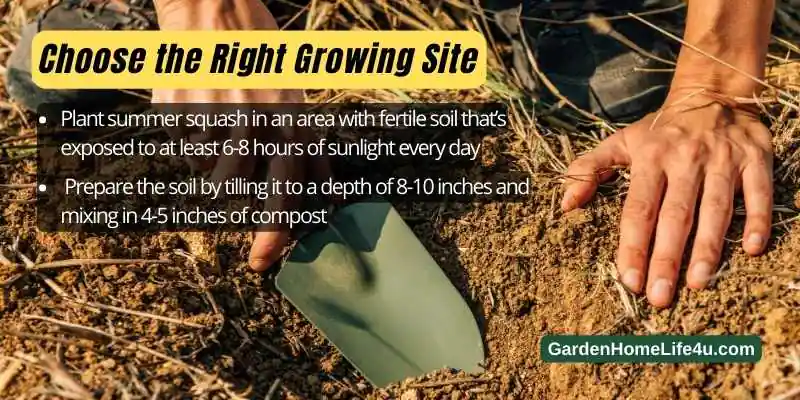Summer squash is a versatile and delicious vegetable that can be enjoyed in a variety of dishes. Whether you want to add it to your salads, soups, stir-fries, or simply grill it as a side dish, growing your own summer squash can be a rewarding experience. But if you’re new to gardening or just want to improve your skills, it can be challenging to know where to start. That’s where this ultimate summer squash growing timeline comes in. From seed to harvest, we’ll guide you through the entire process, step by step. You’ll learn everything you need to know about planting, watering, fertilizing, and harvesting your summer squash, as well as some tips and tricks to maximize your yield and quality. So, whether you’re a seasoned gardener or just starting out, let’s dive into the world of summer squash and discover the joys of growing your own.
Summer squash is one of the easiest vegetables to grow in the UK. It’s fast and produces a constant supply of fresh fruit which you can use for cooking or just eating as it is. As well as tasting great, summer squashes are also easy to store for several months so you can enjoy them all year round!
Spring is knocking on the door and hopefully, you are looking to increase your backyard’s vegetable production this year with nutritious and delicious summer squash. With just a little bit of prep, you’ll be enjoying the yummy rewards of a thriving squash crop.
Summer squash – It’s easy, fast, and very rewarding 
Summer squash is easily one of our favorite vegetables to grow in the UK. It’s easy, fast, and very rewarding – especially if you love eating beautiful yellow fruits.
Summer squash varieties are a little different to other squashes and pumpkins as they’re best eaten when they’re young, tender, and not fully mature. They’re also much smaller than their winter cousins so don’t take up as much space on your plot or in your greenhouse!
Summer Squash – The best time to Seed and Harvest
You can seed summer squash directly outside, its best strategy though to seed them indoors around March-April time and be ready to harvest around 60 to 90 days after usually, which comes around rough July to August.
Summer squashes – Best grown outdoors
Summer squashes although can be grown in pots indoors, wouldn’t prefer it due to the fact they love sunlight and open air. We recommend planting them in suitable areas directly or using pots.
Summer squashes – Choose the Right Growing Site. 
Plant summer squash in an area with fertile soil that’s exposed to at least 6-8 hours of sunlight every day. Prepare the soil by tilling it to a depth of 8-10 inches and mixing in 4-5 inches of compost. Plant the squash seeds 1 inch deep, spacing them about 18 inches apart in rows that are spaced 4 feet apart. Water the area deeply after planting and keep the soil moist until germination occurs. Once seedlings emerge, thin out any overcrowded plants so that each plant. The ideal location also has plenty of space, since the plants need room to spread out as they mature. Make sure to clear away any weeds and stones before planting your squash plants or seeds, then add a layer of mulch around each one for extra insulation and water retention.
Summer Squashes – Grow in POTS
Summer squash plants can be grown in pots or directly in the soil. If you want to grow them in pots, choose large pots (at least 20-liter capacity) and use rich potting compost mixed with plenty of well-rotted manure or other organic matter (such as garden compost).
Summer squashes do not like being root-bound so make sure that your plant is getting plenty of room to spread out – at least 60cm diameter is ideal!
Again, the fact remains they adore the sun so be sure to place the pots strategically in the garden.
Provide Nutrients for Healthy Soil.
Healthy soil is crucial for planting and growing summer squash, so make sure to use a quality fertilizer or compost before planting seeds or seedlings. Fertilizers provide essential nutrients that help squash plants grow quickly and produce abundant yields. Additionally, any organic matter dispersed into the plant bed will help the soil retain moisture and keep pests away. Avoid using too much fertilizer at once, as this can damage your plants and create an unbalanced soil environment.
Plant Your Seeds at the Right Time
Planting your summer squash seeds at the right time and depth is key to successfully growing this vegetable in your garden. For most areas, wait until 4 to 6 weeks after the last frost date of the season before planting squash outdoors.
Choose Appropriate Varieties of Summer Squash for Your Garden Conditions 
Different varieties of summer squash are available that are suitable for different soil and climate conditions. Summer squashes like zucchini, pattypan, crookneck, and scallop squash grow best in warm weather. For cooler climates, choose tried-and-true varieties such as ‘Eight Ball’ zucchini or ‘Cocozelle’ straight-neck squash. If you have limited space, select bush versions of your preferred variety – these take up less space but still produce plenty of delicious fruits!
You can grow summer squash from seeds or buy young plants for your garden/pots. Young plants are often easier to facilitate a good crop – especially during short UK summers.
You can choose from the following popular varieties of summer squash:
- Courgettes – are probably the most common type of summer squash
- Yellow Squash
- Patty Pan Squash
- White Bush Marrow
Quick notes on Courgetts – Our favorite Summer Squash
Every time we have planted courgettes in our garden, we have been surprised by the size of the harvest and how quickly it becomes available to harvest. Hence we thought it might be worth mentioning a few points regarding this delicious summer squash.
- Courgettes prefer well-draining soil that is rich in organic matter and has a pH between 6.0 and 7.0.
- Courgettes require full sun exposure, at least 6 hours a day.
- Keep the soil consistently moist but not waterlogged.
- Water at the base of the plant and avoid getting water on the leaves to reduce the risk of fungal diseases.
- Courgettes thrive in warm temperatures between 18-30°C.
- Give each plant enough room to spread, about 80 cm apart.
- This vegetable can be heavy, Provide a trellis or support system for the vines to grow on to keep the fruit off the ground.
- Feed courgettes with a balanced fertilizer every 2-3 weeks, especially during the flowering and fruiting stage.
- Keep an eye out for pests such as aphids, cucumber beetles, and squash bugs and control them through physical removal, or appropriate pesticides.
Squash plants have big leaves
These are such big plants that they can grow to cover relatively large areas, not so much height-wise though. Make sure that young plants don’t get shaded by larger plants as this may reduce your crop significantly.
Even if you’ve never grown your own fruit or vegetables before, it’s worth giving this one a try as of ease of maintenance and fast growth – they only need watering every few days and don’t require much maintenance beyond that!
Growing Summer Squash is easy and fun 
Growing summer squash is easy and fun – give it a try!
This is one of the easiest vegetables to grow, and it can be done in containers on the patio. There’s nothing more rewarding than harvesting your own produce from the garden—and kids love to get involved, too. Summer
Summer Squashes – FAQ:
How Easy it is to Grow Summer Squashes?
Summer squashes are generally easy to grow and are a great option for beginner gardeners. They are fast-growing, making them a popular choice for home gardeners. You can start summer squash seeds indoors about 6-8 weeks before your last frost date. Mulching around the base of the plants can help to retain moisture in the soil and prevent weeds from growing. Choose a location in your garden that receives plenty of sunlight. Squashes prefer well-draining soil that is rich in organic matter. Squashes need regular watering to thrive. Squashes are heavy feeders and may benefit from a balanced fertilizer once a month during the growing season.
Is Summer Squash a Good Choice for Beginner Gardeners?
It is definitely a choice for beginners. Summer squash is a fast-growing plant that requires minimal care. It produces a large yield, so even a small garden can yield a lot of produce. Summer squash has a relatively short growing season, usually around 60 – 90 days from planting to harvest. Summer squash can be used in a variety of dishes, from salads to stir-fries to grilled dishes.
Is Summer Squash Worth Gardening?
Absolutely, summer squash is worth gardening. Summer squash is a nutrient-dense vegetable that is rich in vitamins A and C, potassium, and fiber. Summer squash can be used in a variety of dishes, including stir-fries, salads, grilled dishes, and more. It can be cooked in a variety of ways, including roasting, sautéing, and grilling. Summer squash is a fast-growing plant that requires minimal care. With proper soil preparation and regular watering, summer squash will thrive in most home gardens. Summer squash produces a large yield, so even a small garden can yield a lot of produce. This is great for home gardeners who are looking to grow their own food. Growing your own summer squash can save you money in the long run.

